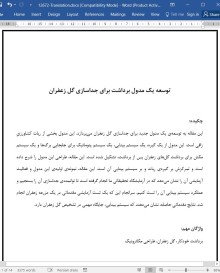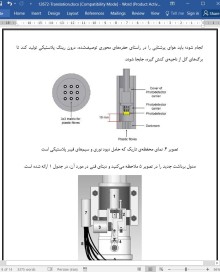
دانلود مقاله توسعه یک مدول برداشت برای جداسازی گل زعفران
چکیده:
این مقاله به توسعهی یک مدول جدید برای جداسازی گل زعفران میپردازد. این مدول بخشی از ربات کشاورزیِ زافی است. این مدول از یک گیره، یک سیستم بینایی، یک سیستم پنوماتیک برای جابجایی برگها و یک سیستم مکش برای برداشت گلهای زعفران پس از برداشت، تشکیل شده است. این مقاله، طراحی این مدول را شرح داده است و تمرکزش بر گیرهی ربات و بر سیستم بینایی آن است. این مقاله، نمونهی اولیهی این مدول و فعالیت آزمایشی آن را نشان میدهد که در آزمایشگاه تحقیقاتی ما انجام گرفته است تا توانمندی جداسازی آن را بسنجیم و عملکرد سیستم بینایی آن را تست کنیم. سرانجام این که یک تست آزمایشی مقدماتی در یک مزرعه زعفران انجام شد. نتایج مقدماتیِ حاصله، نشان میدهند که سیستم بینایی، جایگاه مهمی در تشخیص گل زعفران دارد.
1. مقدمه
گل کورکوس ساتیووس، شبیه لولهای است که از شش گلبرگ مشابه و بنفشرنگ تشکیل شده است که لاکینی نامیده میشوند. در میان آنها، گل کورکوس ساتیووس دارای سه کلالهی قرمز روشن است که از آنها زعفران گرفته میشود. این گل در میان برگها رشد میکند: آنها مانند اجسام دراز و خطی و به رنگ سبز تیره ظاهر میشوند. همانطور که در تصویر 1 ملاحظه میکنید، این برگها معمولاً در نزدیکی گلها ظاهر میشوند. فقط پس از یک بازه زمانی مشخص، برگها از گل باز میشوند تا به سمت زمین کج شود.
برداشت زعفران در میانهی اکتبر آغاز میشود و میتواند تا حداکثر چهار هفته ادامه یابد. برداشت بصورت دستی و در ساعات اولیهی صبح که گلها بسته هستند یا وقتی که تازه شروع به باز شدن کردهاند، انجام میشود. به دلایل زیر لازم است زمانی گل برداشت شود که بسته است: گلهای بسته را راحتتر میتوان برداشت کرد؛ گلها آسیب کمتری میبینند؛ کلالهها در معرض نور آفتاب قرار نمیگیرند و کیفیت آنها کاهش نمییابد؛ تماس بین دست و کلاله صورت نمیگیرد و به این ترتیب از زوال و خرابی کلالهها بر اثر دستکاری، اجتناب میشود. فرایند دستی برداشت زعفران، اینگونه است که ساقه گل بین شست و انگشت سبابه قرار میگیرد؛ سپس ساقه بوسیلهی ناخن جدا میشود. لازم است از خراب شدن برگها و مهمتر از آن، از کنده شدن برگها جلوگیری شود. جنبههای مهم برداشت زعفران عبارتند از: یافتن نیروی انسانی برای حداکثر یک ماه در سال؛ هزینهی بالایی که به نیروی انسانی بابت برداشت زعفران پرداخت میشود؛ فرایند برداشت بسیار توانفرسا است. سرانجام اینکه بهرهوری در این روش برداشت، بسیار پایین است: برای کسب یک کیلوگرم زعفران، باید دویست هزار گل برداشت شود؛ هر هکتار زمین زیر کشت زعفران، نیازمند 1600 ساعت کار یک نیروی انسانی است، تا محصول آن برداشت شود. به این دلایل، خودکارسازی یا شِبهخودکارسازی برداشت زعفران میتواند باعث افزایش بهرهوری گردد و به بهبود کیفیت کار اپراتور بیانجامد.
4. نتیجه
یک مدول برداشت جدید برای جداسازی گل زعفران، بهصورت بخشی از ربات کشاورزیِ زافی، در این مقاله ارائه شده است. تحریک الکترومغناطیسی بر مبنای دو سولنوئید و یک فنر، با موفقیت مطرح و بصورت آزمایشی معتبر شناخته شد. به دلیل ناخرسندی از نیروی بستن گیره که طی تستهای آزمایشی در آزمایشگاه تحقیقاتی، بروز یافت، برخی تغییرات در طراحی اریجنال انجام گرفت. به دنبال نتایج آزمایشی اولیه در مزرعه زعفران، مدول برداشت قادر است با موفقیت شصت درصدی در کنشهای برداشت محصول، ساقه را از گل زعفران جدا نماید. برخی جنبههای مرتبط با سیستم بینایی، باید حل شوند: نمایه گل فقط زمانی بطور صحیح تشخیص داده میشود که گل در مرکز صفحه اسکن باقی بماند. پیشرفتهای بعدی در این زمینه، بر مبنای بهینهسازی سیستم بینایی است تا بتواند نمایه گل را در تمام پوزیشنهای صفحه اسکن، تشخیص دهد.
Abstract:
The paper deals with the development of a new module for the detachment of the saffron flower. The module is conceived to be a part of the Agri-robot Zaffy. The module is composed of a gripper, a vision system, a pneumatic system for leaves shifting and a suction system for the harvesting of flowers after detachment. This paper describes the design of the module, with a special focus on the gripping device and on the vision system. The paper also shows the prototype of this module and the experimental activity performed in our research laboratory in order to measure the detachment capability and to test the vision system performances. Finally a preliminary experimental test was conducted in a Crocus cultivation. The preliminary results obtained show that the vision system has some critical positions in detecting the saffron flower.
1. INTRODUCTION
Crocus Sativus flower appears as a tubule made of six violet similar petals, called lacinie. Among them, Crocus Sativus flower bears three bright red coloured stigmas from which spice, called saffron, is derived. Flower grows up among leaves: they appear as linear elongated bodies, dark green coloured. Typically, leaves appear quite close to flowers, as shown in Fig. 1. Only after a certain time period, leaves splay from the flower in order to lean to the ground.
Saffron harvesting starts at the mid of October and can last at the most for four weeks. Harvesting is performed manually in the first hours of morning when the flowers are closed or when they just start to open. It is important to harvest flower when it is closed for the following reasons: closed flowers offer a greater easiness to be harvested; flowers are less damaged; stigmas are not exposed to sun light so that quality is granted; contacts between hands and stigmas do not happen in order to avoid stigmas deterioration by manipulation. The manual procedure of harvesting expects to catch the flower stem between the thumb and the forefinger; then, the stem can be cut (by nail) or can be detached. It is important to avoid leaves deterioration and, above all, leaves cutting. Critical aspects of the saffron harvesting are: manpower finding for a maximum of one month per year; high manpower cost incidence on the final saffron cost; harvesting procedure is very laborious for the worker’s back. Finally, productivity is too low: a kilogram of saffron spice requires two hundreds thousand flowers; each hectare of cultivated ground requires about manpower for 1600 hours. Due to these reasons, the automation or semi-automation of saffron harvesting could lead to a productivity increase and to an improvement of operator work quality.
4. CONCLUSIONS
A new harvesting module for saffron flower detachment, as a part of the Agri-robot Zaffy, was presented. The electromagnetic actuation, based on two solenoids and a compression spring, was successful proposed and experimentally validated. Some modification to the original design was carried out due to dissatisfaction of the closing force of gripper, shown during the experimental tests in the research lab. Following the preliminary experimental results in a Crocus cultivation, described in the paper, the harvesting module is able to detach stem and saffron flower with successful results in 60% of harvesting actions. Some critical aspects about vision system are to be solved: the flower profile is correctly detected only when the flower stays in the centre of the scan plane. Next developments will be based on the optimization of the visual system in order to detect the flower profile in every position of the scan plane.
چکیده
1. مقدمه
2. مدول برداشت توسعهیافته
2.1 ربات زافی
2.2 مشخصات فنی مدول جدید
2.3 طراحی مدول جدید
3. فعالیت آزمایشی
4. نتیجه
منابع
Abstract
1. INTRODUCTION
2. THE DEVELOPED HARVESTING MODULE
2.1. Robot Zaffy
2.2. Technical specifications of the new module
2.3. Design of the new module
3. THE EXPERIMENTAL ACTIVITY
4. CONCLUSIONS
REFERENCES
- اصل مقاله انگلیسی با فرمت ورد (word) با قابلیت ویرایش
- ترجمه فارسی مقاله با فرمت ورد (word) با قابلیت ویرایش، بدون آرم سایت ای ترجمه
- ترجمه فارسی مقاله با فرمت pdf، بدون آرم سایت ای ترجمه


